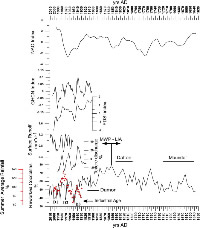Reworked Coccoliths as runoff proxy for the last 400 years: The case of Gaeta Gulf (central Tyrrhenian Sea, Central Italy)
Bonomo S., A. Cascella, I. Alberico, S. Sorgato, N. Pelosi, L. Ferraro, F. Lirer, M. Vallefuoco, L. Bellucci, C. Agnini, G. Pappone
Palaeogeography, Palaeoclimatology, Palaeoecology, Volume 459, Pages 15–28, http://dx.doi.org/10.1016/j.palaeo.2016.06.037
Abstract
We present the results of a high resolution study carried out on a shallow water sediment core, recovered in the central Tyrrhenian Sea to reconstruct the runoff history of the catchment basin of Volturno and Garigliano rivers (Gulf of Gaeta, Italy), over the past ~ 400 years. We compared the abundance distribution pattern of Reworked Coccoliths to the surface runoff model simulation for the Volturno and Garigliano hydrographic river basins, the Global Historical Climatology Network index, the Palmer drought severity index, the Tevere river discharge anomaly, the average summer rainfall in Southern Italy and the reconstructed North Atlantic Oscillation signal. This comparison suggested that the biotic signal of the Reworked Coccoliths may be used to detect climatic events from local to “global” scale. The calcareous nannofossil assemblages as well as their diversity index are modulated by oscillation in solar activity, where minima in solar activity correspond to minima calcareous nannofossil diversity and vice versa. In particular, the antiphase correlation between the abundance of Reworked Coccoliths and the North Atlantic Oscillation index, which modulates winter precipitation, suggests that this biotic index could be used as a reliable proxy to reconstruct the variations in the hydrographic basin runoff of the Volturno and Garigliano rivers. In addition, power spectral and wavelet analysis carried out on both signals documented the occurrence of climatic cycles of the duration of about 95 yr. From 1900 AD upwards, a turnover in the periodicity from 95 yr climatic cycles to 22–26 yr cycles occurred in the Reworked Coccoliths signal, suggesting a strong control of solar forcing (Hale cycle) over the last century.
http://www.sciencedirect.com/science/article/pii/S0031018216302309


